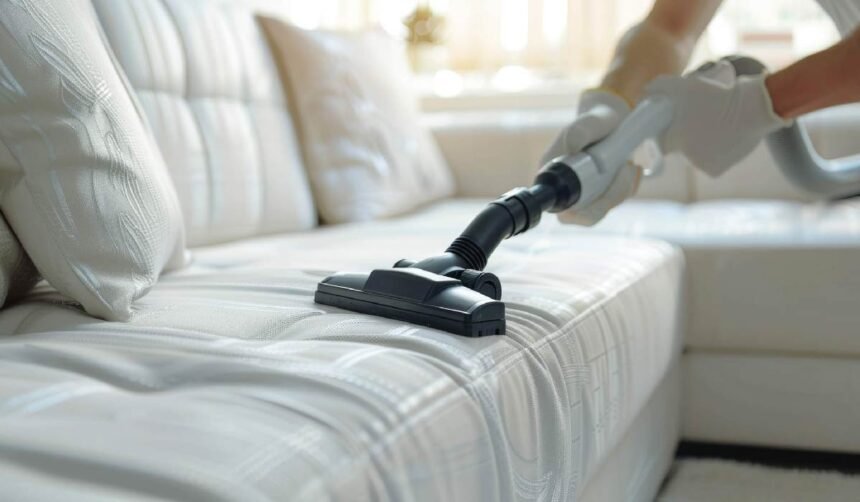Let’s be honest—when was the last time you actually thought about cleaning your couch? If you’re like most people, upholstery cleaning probably falls somewhere between “organizing the junk drawer” and “deep cleaning the baseboards” on your to-do list. We see our furniture every day, so it’s easy to miss the gradual buildup of dust, pet hair, and those mysterious stains that somehow appear overnight.
But here’s the thing: your upholstery works harder than you might think. It absorbs everything from cooking odors to dead skin cells, and without regular attention, it can become a breeding ground for allergens and bacteria. The good news? You don’t need to become a cleaning fanatic to keep your furniture fresh and healthy.
Different rooms have different needs, and understanding these variations can save you time while extending the life of your furniture. Some pieces need weekly attention, while others can go months between deep cleans. Let’s break it down room by room so you can create a realistic cleaning schedule that actually works for your lifestyle.
Living Room: Your Furniture’s Daily Marathon
Your living room furniture gets the workout of a lifetime. Between movie nights, afternoon naps, and that spot where everyone gravitates during parties, these pieces see more action than a superhero movie.
Sofas and armchairs should get weekly vacuuming with an upholstery attachment. Focus on the crevices where crumbs love to hide and don’t forget those cushions—flip them over and vacuum both sides. For professional upholstery cleaning, aim for every 12-18 months, or sooner if you have pets or young children who treat furniture like their personal playground.
Ottoman and coffee table cushions need similar attention, though they might need spot cleaning more frequently since they often double as footrests, snack tables, and temporary storage for everything from remote controls to homework.
Here are the telltale signs your living room furniture needs immediate attention:
- Visible stains or discoloration
- Persistent odors that don’t go away after airing out
- Increased allergy symptoms when spending time in the room
- Fabric that feels sticky or rough to the touch
Dining Room: Where Spills Happen
Dining room chairs face a unique challenge—they’re magnets for food spills and stains. That beautiful upholstered dining set might look elegant, but it’s also positioned right in the line of fire for every dropped forkful and wine mishap.
For dining room upholstery cleaning, spot clean spills immediately (seriously, don’t wait until after dessert). A weekly vacuum keeps crumbs from settling in permanently, and consider professional cleaning every 6-12 months depending on how often you actually use your dining room.
If your family eats most meals at the kitchen counter and your dining room only sees action during holidays, you can stretch that cleaning schedule a bit longer. But if you’re hosting dinner parties regularly or have kids who somehow manage to get spaghetti sauce on everything within a five-foot radius, more frequent cleaning is your friend.
Bedroom: The Forgotten Furniture
Bedroom furniture often gets overlooked because it seems “cleaner” than pieces in common areas. But think about it—you spend roughly eight hours a night shedding skin cells, and if you’re like many people, your bedroom chair doubles as a clothes hamper.
Upholstered headboards collect dust, hair products, and oils from your skin. A monthly vacuum and quarterly professional cleaning should keep them fresh. Bedroom chairs and benches need weekly vacuuming if they’re used regularly, or bi-weekly if they’re more decorative.
Don’t forget about that chair where you pile tomorrow’s outfit (we all have one). Even if it’s not technically being “sat in,” it’s still collecting dust and absorbing odors from clothes.
Kids’ Rooms: The Danger Zone
Children’s furniture needs the most frequent attention, and honestly, it deserves combat pay. Between art projects gone wrong, midnight snacks, and the occasional sick day accident, kids’ upholstery sees it all.
Weekly vacuuming is non-negotiable, and spot cleaning should happen immediately after any incidents. Professional upholstery cleaning every 6-8 months helps maintain a healthy environment and extends the life of furniture that takes serious abuse.
Consider using washable furniture covers or throws in kids’ rooms—they’re much easier to clean than the actual upholstery and can be lifesavers during flu season or creative phases involving finger paints.
Creating Your Personal Cleaning Schedule
The key to successful upholstery maintenance isn’t following someone else’s rigid schedule—it’s creating a routine that fits your lifestyle and household needs. A single person with no pets might get away with less frequent cleaning than a family of five with two dogs and a cat.
Start by assessing each room honestly. Which pieces get daily use? Where do you eat snacks? Which furniture doubles as pet beds whether you intended it or not? These high-traffic, high-risk pieces need more attention.
When to Call in the Professionals
Sometimes DIY just doesn’t cut it. Professional upholstery cleaning becomes necessary when you’re dealing with set-in stains, persistent odors, or delicate fabrics that need special care. Most furniture benefits from professional attention at least once a year, but don’t feel guilty if life gets busy and you stretch it to 18 months.
The investment in professional cleaning often pays for itself by extending your furniture’s lifespan and maintaining a healthier home environment. Plus, there’s something deeply satisfying about seeing your old couch look fresh and new again.
Remember, consistency beats perfection. A quick weekly vacuum is infinitely better than putting off cleaning until your furniture looks obviously dirty. Your future self (and your furniture) will thank you for the regular attention.








